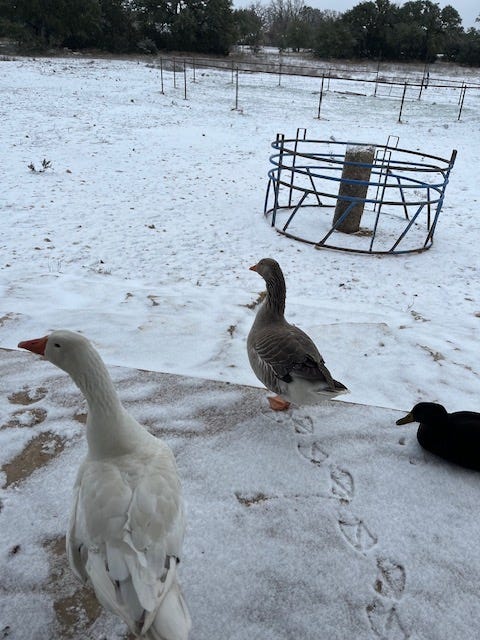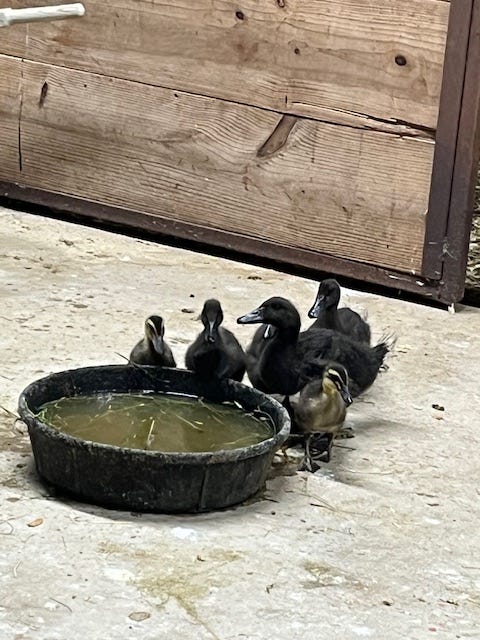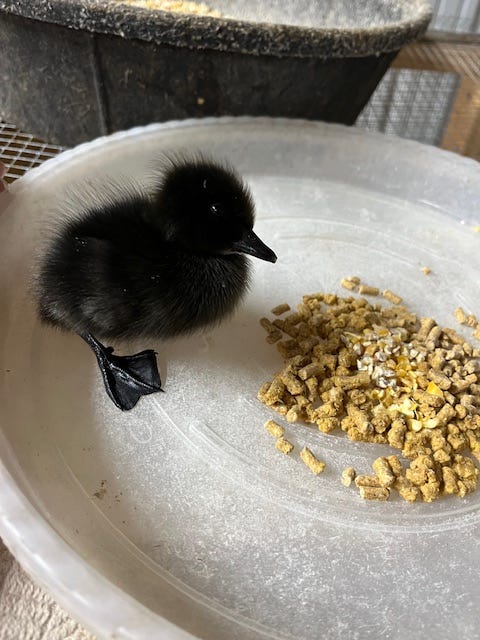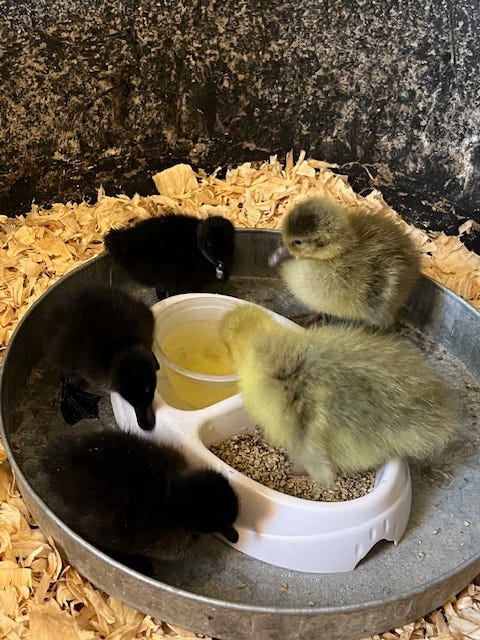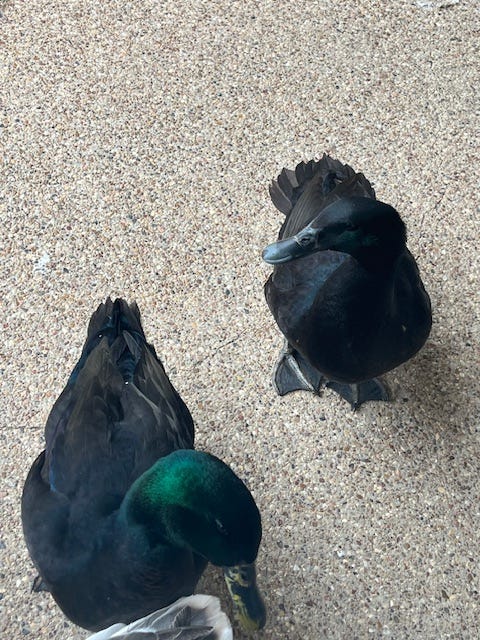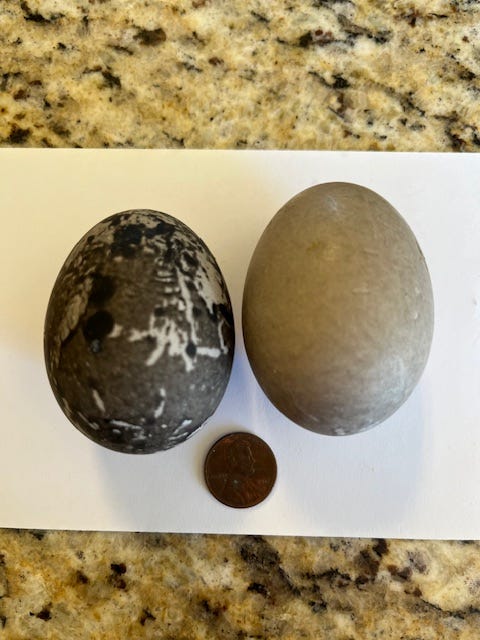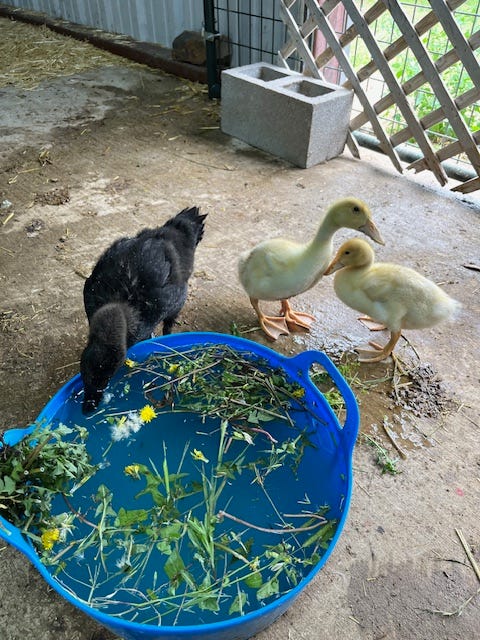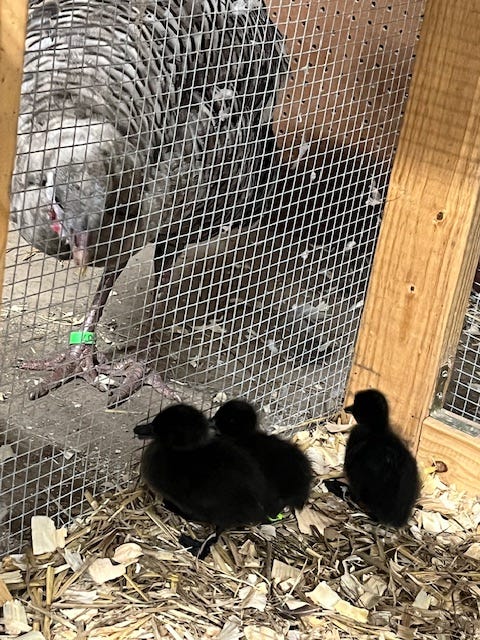Cayuga ducks
an introduction
Homesteading with ducks is something I’m new to, so I made this post to help others get interested in ducks and find advice.
Pros of duck ownership:
They are very cute and even as adults, don’t have any real weapons to defend themselves. They are easily handled by children or shy adults (some breeds are more amenable to handling/cuddling than others).
They lay rich, large eggs with a harder shell, for a longer season than chickens.
They forage extremely well and will eat anything and a lot of things chickens won’t like slugs, snails, large beetles, etc.
No pond is necessary for raising ducks. They need a water source deep enough to dunk their heads in and really appreciate water to swim in to clean themselves, mate in and wash away parasites. Most duck owners, myself included, get by with a (easily drained, cleaned and filled) kiddie pool.
They don’t damage flowerbeds or plants. They don’t make dust baths the way other poultry can and don’t have the pecking or serrating ability to decimate plant growth. Because they eat so many bugs, I like to give them monitored access to my garden. If they find water or mud, they will make bill-sized holes in the ground, which for me just helps to aerate and get water deeper into the ground.
They are highly weather-tolerant compared to chickens. In the summer if they have access to swimming water, they cool themselves off well. In the cold, they have layers of downy feathers and body fat that keeps them insulated. I notice they will move around, then lay down to warm up their feet under their feathers before moving on again. Their absolute favorite weather is rain and mud, which humans and other birds alike avoid, but ducks thrive in this.
My Pilgrim geese and Cayuga drake Getafe in their first snow. Getafe demonstrates the laying down position to warm up feet before continuing business as usual.
I’m not at this point yet in my flock management, but duck meat is very dark and fatty. Rendered duck fat is a prime ingredient even in non-duck meat dishes because of its flavor. Their feathers and down can be used for blankets, clothing, lures, decorations. Duck liver (foie gras) is a delicacy that can be achieved and enjoyed without the gavage technique employed by factory farms.
They are relatively low maintenance as far as housing (no roosts needed, weather tolerant, cheap bedding) as long as it’s predator-proof.
You can get day-old ducklings mailed to your nearest post office. Before hatching, ducks absorb nutrients from the egg to enable hatching and recovery without needing to feed for a day or so. This allows reputable hatcheries to ship babies with a heat source and nutrient gel successfully, almost to your house. It’s very convenient and works well from big hatcheries.
Day-old hatchlings arrive as a group in a thick box with a heat source and nutrient gel. Only order from reputable hatcheries that will insure any shipping losses.
I recommend this method for starting your flock, because feed stores selling babies are usually impulse buys by unprepared people that end up dumping domestic animals into the wild. Purchases cannot be returned to the store and usually suffer the same fate as unsold babies (it’s not pretty and is a dirty secret your chain feed store would like to keep quiet).
My Cayugas with two striped Rouen ducklings (feed store rejects that would have been destroyed otherwise).
Another way to procure ducks is through local farms and hobbyists who market using websites. I suggest this only after raising your own ducklings successfully to fully understand what healthy ducks look like and be able to maintain your own flock’s health through quarantine and treatment.
Their manure can be applied directly (bedding included) to plants without aging or composting as it’s mostly water.
They are not as noisy as other birds (relatively). In ducks, the females are actually noisier than the males and QUACK when they’re broody or upset. Males make raspy noises which aren’t loud, but most backyard duck owners will have females anyway.
They can be more disease- and injury-resistant compared to chickens. This makes it better for kids and novice flock managers.
Ducklings grow and develop quickly. It takes them weeks to have the foraging and feathering that takes my turkeys months. In my first go with ducks, I had purchased hatchlings, started a cohesive foraging flock, got eggs and hatched eggs from those ducks before even a year had passed. My ducks started laying at five months and at this time (eight months of age) my drake ensures fertility and I have ducklings hatched - a great return after half a year.
The Intrepid, first generation duckling hatched here at home. Parents are less than a year old.
Cons of duck ownership:
They are MESSY. They skidmark poop constantly and where they eat, swim and sleep. They spill food into their water and water into their food and on the floor and on themselves and get dirt in their water and it goes on and on…
Everything on this planet likes to eat ducks and their eggs (humans, dogs, cats, hawks, critters, snakes, etc). They are predated on heavily, so always purchase extras to account for inevitable losses.
My day-old replacement ducklings and goslings shipped together. I went through three shipments and got geese as flock protectors before my adult flock was established.
28 day+ hatch time, more for Muscovies (chickens are 21 days and other poultry can be similar or longer).
They need supplemental niacin in their diet depending on age, breed and husbandry style. Some feed companies consider this, selling waterfowl feed or include niacin and high protein in an “all-flock” blend. Young ducks, heavy fast-growing breeds (Pekin) and ducks that cannot forage will need supplemental niacin.
They can fly. Different breeds have varying levels of ability, but this is something to be considered carefully since you don’t want your investment literally flying away. Breed ability, fencing height and even wing clipping can help - some. Cayugas are a “low” flying ability breed on paper, but my drake can still clear a 4ft livestock fence with clipped wings when he gets riled up. My girls only run along the ground, flapping.
They can bully other flockmates. My ducks like to tuck their neck in and run at other birds, especially smaller/younger ones and over resources like food and water. Drakes can chase other birds, grab neck feathers and mortally injure those with different equipment (chicken hens). Drakes can also overmate and injure females, even their preferred female among many. Flock management to provide a correct male to female ratio, hiding spaces and eliminating damaging behaviors (freezer camp) is necessary.
They can lay their eggs wherever inspiration strikes. They make their nests on the ground, so nesting boxes are ignored. I have tried letting them out to forage later in the morning, but that doesn’t always work. I have had to hunt for eggs in flowerbeds and completely random places in the barn. What has worked has been to let some eggs accumulate in an approved location - then they will be consistent and keep depositing eggs there.
Duck eggs can also be dirty, depending on where they are laid and how much it was rolled or kicked around before being collected. That said, I store my eggs at room temperature unwashed until I’m ready to cook them. Because of this storage technique and a thicker shell, duck eggs can have a long shelf life. A heavily soiled egg is either put into my snake trap (the smell can actually attract them) or scraped to remove the worst of it.
They can be taught basic tricks (mine jump to eat grapes out of my fingers and run up to me when they see me), but overall intelligence and savviness is not their forte. My turkeys will put themselves in the barn at dusk and right before rain comes, but the waterfowl roams around in the semi-dark looking for me. As flattering as that is, it’s the most unsafe part of the day for them. I can easily catch my ducks if I have a space I can corner them in, since they don’t fly to get away from me and don’t have teeth or claws to fend me off.
Cayuga Ducks
Next, I will explain why I chose this breed to homestead with and how reality has compared with the information I researched before getting my ducks. I have not included the history of Cayugas, as there is the same and conflicting information available anywhere about their history. They are a mallard-based breed (as opposed to Muscovy ducks, which are their own branch genetically and breeding to mallards creates a hybrid moulard or hinny duck). They are from and named after the Cayuga lake region in New York, an American breed currently listed as Watch status by conservancy groups.
As ducklings, they are solid black (sometimes with a yellowish tinge on their head and bib) with black bills and feet. As adults, they are uniformly solid beetle green-black with some very dark blue wing feathers. Males will develop a shimmery greener head and neck, curly tail feathers and a yellowed bill and feet. Females maintain a dull black bill and feet and can begin developing white body feathers with every molt. There is some debate on if their coloring can help protect them from predators since they look like other undesirable birds (ravens, for example), but regardless they are beautifully colored in the sunlight. Cayugas are one of the few breeds that have this distinctive shiny green-black coloring.
Drake Getafe in the front (yellowed bill, green head) and duck Rayo on the right.
Size: A normal sized duck, between 5 and 7 lbs grown. They are the smallest members of my mixed flock (turkeys and geese). When I pick them up, I’m surprised by how little they weigh - mostly feathers and compared to my other birds, but they are extremely manageable. Heavier meat breeds (Pekin) have health issues and require more nutrition, so this size duck was what I wanted.
Eggs: One of the interesting listed things about Cayuga eggs is that females lay marbled-looking eggs that lighten up as the season goes on. My ducks started laying consistent eggs daily at 5-6 months of age. Compared to turkeys, the age was the same, but my starting hens can have egg issues (shell-less, double yolkers, busted from laying on the roost) and lay every other or every few days. Cayuga “dark” eggs are also a possibility, but not a certainty. My older duck began laying at 5 months old and they were all and have been an off white color. My younger girl began at 6 months of age and gave me a marbled egg that faded within three days to its regular color of very light grey*. If I give duck eggs to anyone, I have to stipulate that they are duck eggs and that is their normal color or people think they are weird or rotten. It’s also much harder to crack duck eggs for baking - pro tip: crack all the way around the middle of the egg and slowly insert your thumbs into the membrane, or else you’ll get shell pieces that fall in.
Since I don’t have a pond and my ducks forage all day, their eggs have a rich taste with no hint of fishyness. Overcooking them at all (scrambled, fried, quiche) can make them leathery because the white has a more gel-like consistency than chicken eggs. They have more yolk to white ratio than chicken eggs, with a deep orange yolk. Duck eggs will excel in baked goods and my favorite - cheesecakes - especially if whipped well while mixing the recipe. There are also key differences in using room temperature vs. refrigerated eggs: follow the recipe details or use cold eggs for fluffiness, room temp for density.
Temperament: I neglected to read carefully the temperament rating of Cayugas from my hatchery (third nervous breed) as I was dazzled by the other details. Even though I read that these ducks can be preferred for duck herding trials (yes, it does exist and is really cool to watch, both the dogs and the ducks!), I think it’s more because of their grouping up ability. I would not consider the Cayuga a very cuddly duck, even though they are easy to handle once caught. My ducklings have gotten into their water dish pretty much immediately and enjoy running around as a gang for no apparent reason. It’s entertaining for me, but the rest of the flock tries to get out of the race course, especially as the galloping ducks grow bigger. What I wanted more than pet aptitude or cuddliness was their ability to range and forage and they exceed in that area. They keep a watchful eye on anything in the sky - even far away jetliners - and when napping keep one eye open on the surroundings. I have only lost ducklings inside, at night to snakes. Adulthood and adding a pair of protection geese to my waterfowl flock has meant no losses to daytime predators.
Health: I make sure niacin, protein, grit and calcium supplementation is available on top of quality feed and foraging. Ducklings get the first two from an all flock feed and brewer’s yeast. I stop the yeast after they are foraging regularly (5-6 weeks) because they have access to the feed at least twice a day. Grit is all around them, free choice while foraging and is extremely important for digestion. Ducks will eat almost anything and need the grinding action of dirt and small stones to break down large or fibrous things they have eaten. Calcium is needed by laying ducks for hard eggshells and to prevent their bones from being weakened. I buy oyster shell and leave it near a water source, to help them wash down the chunks they pick up in their bill. Snailshells are also a good source of calcium, I will step on really large ones and the ducks come along and vacuum it up - especially if there is still a snail inside!
When they are ducklings, I will pick pieces of green plants (safe grass, leafy plants and all parts of dandelions especially) and put them in their water. Floating greens mimic a pond environment to teach them to forage for greens and filtering behavior (they use their bill in water or mud to filter out food). Floating treats like oatmeal flakes and mealworms are stimulating to ducklings as well, along with good nutrition and training (human=yum).
Access to water is the most important thing to raising ducks. As ducklings, you can use vitamin water to boost them after hatch or shipping. They also need water near their food to wash it down and into their crop and to prevent impaction or pasty butt. They also need clean water for dunking their whole head to wash out their eyes and nostrils, since there is no other way for ducks to clean them. If it’s very cold outside, I take warm water out for my ducklings to drink and bathe in and can’t help but compare their bubble-making endeavors to kids drinking chocolate milk. There were a lot of warnings against letting ducklings swim (I think because they can get tired and drown and because hatchery ducklings don’t have access to mom’s feather oils to aid in floating and waterproofing). I have never been able to keep my Cayugas out of their water, regardless of hatchery, natural, or incubator hatch - they simply love the water. It’s hard to keep their water fresh, but worth having a swim area that’s easily cleaned and refilled. My Cayuga ducklings enjoy playing submarine under even shallow water, which develops their ability to get clean by bathing and stimulates their own oil-producing gland above the tail. You can observe days-old ducklings in standing water using their head to splash water onto their back and begin grooming with their bill and head.
My Cayugas have been healthy compared to other breeds. For a short period - due to snake losses and waiting on replacement ducks to ship - I bought two feed store ducklings to keep my lone survivor Cayuga company. These guys were probably three or four weeks old based on their feathering and though not labeled as any breed, were Pekins. They had had zero human interaction and were very flighty. I doubt said feed store was interested in or even knew about niacin requirements, so these ducks had very bowed legs and would get tired trying to keep up with my Cayuga. Their entire life up to that point had been inside a trough, so I think lack of exercise also contributed to the bowing. They would try to follow my Cayuga around the race course and while foraging, but would lay down often from tiredness. After a week or so of niacin, exercise and ability to swim, their legs did straighten quite a bit and their stamina matched my Cayuga’s. Once they got old enough to contemplate breeding and to keep my breed pure, I rehomed them with a friend.
My Cayugas have not experienced being eggbound, lameness or sudden death. One of my ducks has the very beginning of Angel Wing, but she would not tolerate bandages or wraps, it only affects her esthetically and has not progressed. No one’s really sure what causes Angel Wing, but it’s possible too much protein can (brewer’s yeast has niacin but also protein, which unwittingly bumped up the amount I was feeding).
I deworm young flockmates preventively and any new introductions to the flock. I use horse paste inserted into hollowed-out grapes to make it as enjoyable as possible. Little ones or adults that don’t understand grape awesomeness get paste put into their beak/bill and their neck rubbed to help them swallow. The horse paste is safe to use and I always overdose a bit to make sure it’s effective. I don’t have wormy flocks or deworm so often to be concerned about resistance and haven’t had symptoms of worms the horse paste doesn’t kill.
I did have some turkey hens I bought come in with lice. That was my fault as I didn’t check the newcomers over well enough and should have. Lice spray was applied to all of the turkeys on their skin and repeated every week to 10 days a couple times. When I change out bedding completely, I add a layer of deodorizing clay and spinosad dust before adding new bedding and that has eliminated the lice issue. I have never seen lice or mites on the waterfowl, mainly because they have daily free access to deep enough water to swim in and drown parasites.
Noise: Cayugas are not quiet ducks. As ducklings, they were kept in my husband’s office inside a brooder trough and peeped constantly. Any stimulation (light, noise, temperature) would get them going again. As adults, my drake makes a raspy wack wack noise, but the ducks can quack loudly and are more consistently making sounds. They will quack softly and continuously while foraging, more insistently if they are interested in something (those hay bales sure are fascinating!), loud if they hear splashy sounds (filling or cleaning the pool) and very loudly if something is wrong. When they are separated from the others or want in or out, you will know it.
Flying ability: Hatchery charts will list Cayugas as low to none flying ability, but this isn’t quite true. The girls run flapping along the ground and can occasionally get about a foot off the ground. My drake on the other hand can fly quite high and for a distance enough to put him in danger. Even after clipping one wing to destabilize him while flying, he adapted and can fly just as well when he gets riled up. This happens regularly when my geese (also supposed to have low/zero flying ability, mind you) get to flapping around the pasture and into the yard several times a day. They do it to get somewhere faster and it’s efficient, so I would consider Cayugas a flight risk under the right circumstances.
Brooding and mothering: My Cayugas have been good at laying consistently and hiding their eggs. I was letting eggs collect to see if one of my girls would decide to sit. My young turkey hen took an interest in the nest and would lay her eggs in there as well. Daily I would check the nest, remove turkey eggs for eating, date the fertile eggs (my drake only likes to mate one of my ducks, so I confirmed only her eggs were fertile) and put them back. I had collected close to twenty eggs when my turkey hen decided she was going to sit the eggs. The first few days before she committed, she would claim the nest during the day and fly to roost with the others at night. Overnight my fertile duck would cover the nest. So what began as a duck-broodiness test ended with a turkey mom to three ducklings. I had to incubate two of the eggs and add them to mom and ducklings later because the timing of their hatch was off by as much as six days.
I will update again as these ducklings grow to track sex and hardiness and update on my ducks as laying season picks up again*. Some things I learned from this experience: fresh duck eggs hatch best (less than a week old), duck embryos are easier to see than turkey eggs when candling and Cayuga duckling behavior is similar regardless of incubator or natural hatch (even if “mom” is not your same species). This was important to prove or disprove the lack of oils from mom affecting ducklings’ ability in the water.
*I had begun marking and leaving eggs in the duck stall to entice them to lay only there. What I thought was the ducks slowing down laying eggs because of the cold was actually them hiding a stash of eggs every day in my flowerbed! So my Cayuga girls have been very consistent with an egg a day since 5 months old and sneaky about hiding them.



